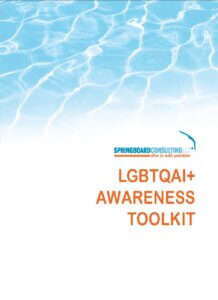LGBTQAI+ AWARENESS TOOLKIT
This toolkit will help you tap into a valuable “hidden” candidate pool of qualified workers.
 |
LGBTQAI+ Awareness ToolkitFormat: Electronic (PDF) Total Number of Pages: 42 Cost: $5,000 USD – Includes a royalty-free, paid-up, non-exclusive |
ABOUT THIS TOOLKIT
THE “HIDDEN” CANDIDATE POOL
The 28 million small businesses across America play a vital role in local economies. We represent 99.7 percent of all of the employers in the U.S and employ over 56 million people, or 57 percent of the private sector employees in the nation. We also create new jobs – roughly 80% of new jobs in the country – and give people the opportunity at employment by providing 67% of all first jobs . We provide job opportunities to different types of workers and rely heavily on our people for success. Increased diversity in our staffing strategy helps to increase our potential for success.
Today, our nation benefits from an increasingly diverse workforce, one that offers a number of different perspectives and rich ideas to American businesses of all sizes and in all industries.
Between 2010 and 2030, the country will lose 20% of its workforce . To maintain the jobs we have now, without growing the workforce, our country needs to add 10-15 million new workers between now and 2020. One “hidden” candidate pool that will help us fill our vacant positions is people with disabilities. Every day, people with disabilities, including lesbian, gay, bisexual and transgender (LGBT) people with disabilities, make significant contributions to workplaces across the U.S. Yet, many small employers remain reluctant to hire people with disabilities. People with disabilities continue to be unemployed at much higher rates than people without disabilities, despite being qualified, valuable workers.
People with disabilities are the next great wave of diversity in the United States and around the globe. In fact, they are the largest minority in America today and still growing, especially when we include maturing workers with age related disabilities and veterans with service related disabilities. Employees who have a disability or who have a child or other dependent with special needs represent approximately 15% of the U.S. workforce. Currently, in the U.S., this segment of the population has exceeded the Hispanic population by 5%. People with disabilities want to work and, in fact, come to employers with education and skill-sets that make them ideal candidates for a great many jobs, especially when utilizing technology that helps level the playing field.
Additionally, the LGBT community encompasses the full spectrum of our society’s diversity. Employees who are LGBT represent approximately 7% of the U.S. workforce. The LGBT community crosses lines of gender, race, age, income, class, family structure, education, geography, religion and political affiliation and also includes individuals with disabilities. In fact, research indicates that disability is significantly more prevalent among adults who are LGBT.
Many large companies now include sexual orientation and gender identity in their diversity and inclusion efforts. Over 91% of Fortune 500 companies now include sexual orientation in their non-discrimination policies and 61% include gender identity . LGBT employees now have more choices where to take their talents.
The intersection of disability and LGBT issues in the workplace represents a unique opportunity for us to increase the inclusiveness of our workforce and tap into a valuable “hidden” candidate pool of qualified workers.